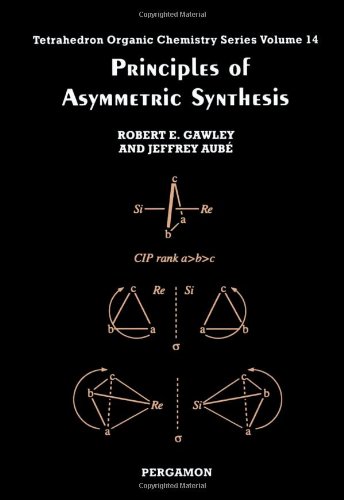Principles of Asymmetric Synthesis (Volume 14) (Tetrahedron Organic Chemistry, Volume 14) - Tapa dura

Sinopsis
The world is chiral. Most of the molecules in it are chiral, and asymmetric synthesis is an important means by which enantiopure chiral molecules may be obtained for study and sale. Using examples from the literature of asymmetric synthesis (more than 1300 references), the aim of this book is to present a detailed analysis of the factors that govern stereoselectivity in organic reactions. It is important to note that the references were each individually checked by the authors to verify relevance to the topics under discussion.
The study of stereoselectivity has evolved from issues of diastereoselectivity, through auxiliary-based methods for the synthesis of enantiomerically pure compounds (diastereoselectivity followed by separation and auxiliary cleavage), to asymmetric catalysis. In the latter instance, enantiomers (not diastereomers) are the products, and highly selective reactions and modern purification techniques allow preparation - in a single step - of chiral substances in 99% ee for many reaction types.
After an explanation of the basic physical-organic principles of stereoselectivity, the authors provide a detailed, annotated glossary of stereochemical terms. A chapter on "Analytical Methods" provides a critical overview of the most common methods for analysis of stereoisomers.
The authors then follow the 'tried-and-true' format of grouping the material by reaction type. Thus, there are four chapters on carbon-carbon bond forming reactions (enolate alkylations, organometal additions to carbonyls, aldol and Michael reactions, and cycloadditions and rearrangements), one chapter on reductions and hydroborations (carbon-hydrogen bond forming reactions), and one on oxidations (carbon-oxygen and carbon-nitrogen bond forming reactions). Leading references are provided to natural product synthesis that have been accomplished using a given reaction as a key step.
In addition to tables of examples that show high selectivity, a transition state analysis is presented to explain - to the current level of understanding - the stereoselectivity of each reaction. In one case (Cram's rule) the evolution of the current theory is detailed from its first tentative (1952) postulate to the current Felkin-Anh-Heathcock formalism. For other reactions, only the currently accepted rationale is presented. Examination of these rationales also exposes the weaknesses of current theories, in that they cannot always explain the experimental observations. These shortcomings provide a challenge for future mechanistic investigations.
"Sinopsis" puede pertenecer a otra edición de este libro.
Reseña del editor
The world is chiral. Most of the molecules in it are chiral, and asymmetric synthesis is an important means by which enantiopure chiral molecules may be obtained for study and sale. Using examples from the literature of asymmetric synthesis (more than 1300 references), the aim of this book is to present a detailed analysis of the factors that govern stereoselectivity in organic reactions. It is important to note that the references were each individually checked by the authors to verify relevance to the topics under discussion.
The study of stereoselectivity has evolved from issues of diastereoselectivity, through auxiliary-based methods for the synthesis of enantiomerically pure compounds (diastereoselectivity followed by separation and auxiliary cleavage), to asymmetric catalysis. In the latter instance, enantiomers (not diastereomers) are the products, and highly selective reactions and modern purification techniques allow preparation - in a single step - of chiral substances in 99% ee for many reaction types.
After an explanation of the basic physical-organic principles of stereoselectivity, the authors provide a detailed, annotated glossary of stereochemical terms. A chapter on "Analytical Methods" provides a critical overview of the most common methods for analysis of stereoisomers.
The authors then follow the 'tried-and-true' format of grouping the material by reaction type. Thus, there are four chapters on carbon-carbon bond forming reactions (enolate alkylations, organometal additions to carbonyls, aldol and Michael reactions, and cycloadditions and rearrangements), one chapter on reductions and hydroborations (carbon-hydrogen bond forming reactions), and one on oxidations (carbon-oxygen and carbon-nitrogen bond forming reactions). Leading references are provided to natural product synthesis that have been accomplished using a given reaction as a key step.
In addition to tables of examples that show high selectivity, a transition state analysis is presented to explain - to the current level of understanding - the stereoselectivity of each reaction. In one case (Cram's rule) the evolution of the current theory is detailed from its first tentative (1952) postulate to the current Felkin-Anh-Heathcock formalism. For other reactions, only the currently accepted rationale is presented. Examination of these rationales also exposes the weaknesses of current theories, in that they cannot always explain the experimental observations. These shortcomings provide a challenge for future mechanistic investigations.
Reseña del editor
Using examples from the literature of asymmetric synthesism, this text presents a detailed analysis of the factors governing stereoselectivity in organic reactions. Areas covered include: an explanation of the basic physical-organic principles of stereoselectivity; a glossary of stereochemical terms; carbon-carbon bond forming reactions; reductions and hydroborations; oxidations; and transition state analysis.
"Sobre este título" puede pertenecer a otra edición de este libro.
Otras ediciones populares con el mismo título
Resultados de la búsqueda para Principles of Asymmetric Synthesis (Volume 14) (Tetrahedron...
Principles of Asymmetric Synthesis (Volume 14) (Tetrahedron Organic Chemistry, Volume 14)
Librería: Books From California, Simi Valley, CA, Estados Unidos de America
hardcover. Condición: Good. Nº de ref. del artículo: mon0003067924
Comprar usado
Cantidad disponible: 1 disponibles
Principles of Asymmetric Synthesis (Volume 14) (Tetrahedron Organic Chemistry, Volume 14, Band 14)
Librería: Buchpark, Trebbin, Alemania
Condición: Gut. Zustand: Gut | Sprache: Englisch | Produktart: Bücher. Nº de ref. del artículo: 42472293/203
Comprar usado
Cantidad disponible: 1 disponibles

